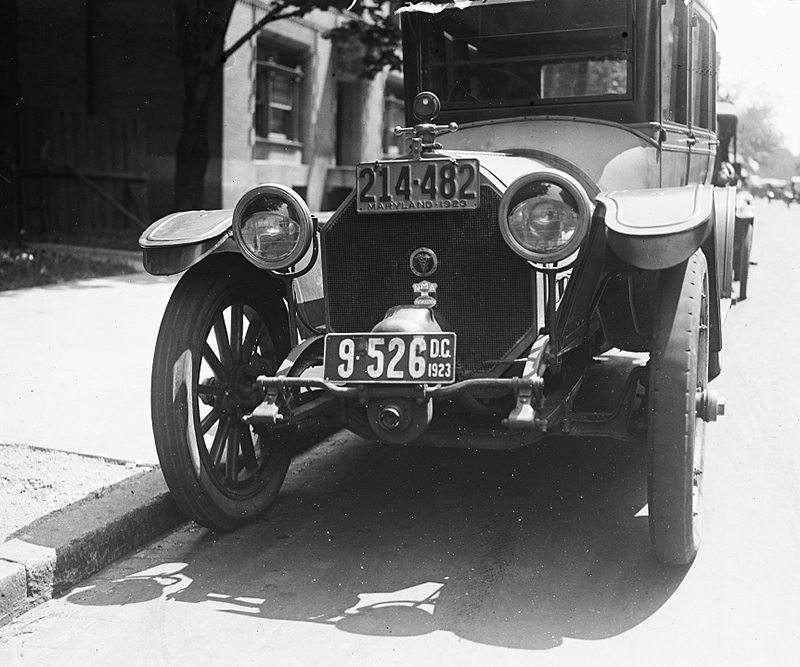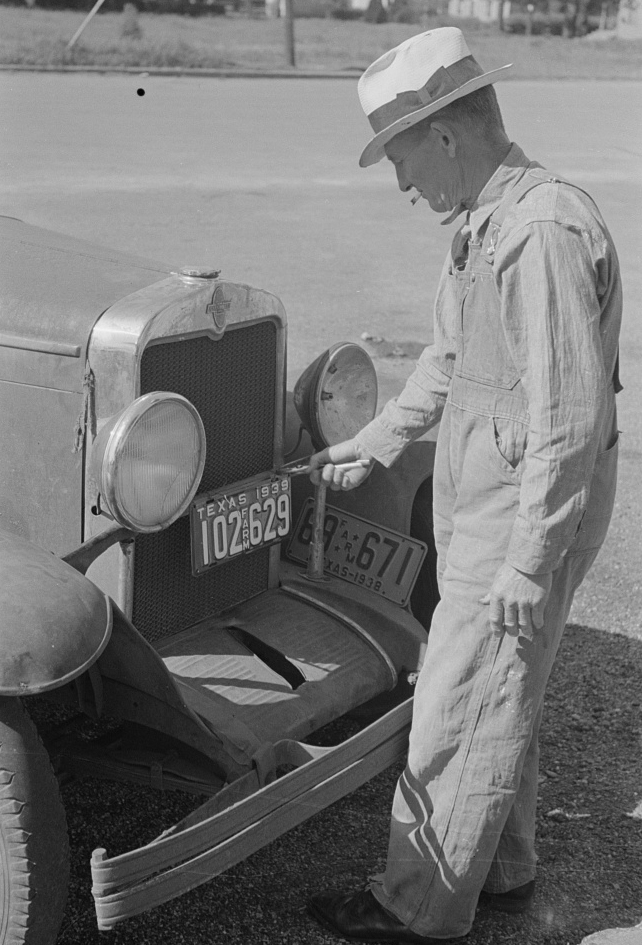Plate Tectonics

Automobile with Maryland and Washington, DC, license plates, 1910. Photograph by Harris & Ewing. [Library of Congress]
The United States is suffering an epidemic of license plate violations. Cars with fake paper temporary tags, plates obscured with plastic, expired plates, bent plates, or no tags at all, suddenly seem to be everywhere. Blame has been attributed to lax enforcement, strong incentives to avoid tolls and fines, and the collapse of social norms. But there has always been strong resistance to license plate laws, highlighting just how hard it is to regulate cars.
Since their introduction in the early 20th century, plates served several uses. One was fiscal: plate requirements enabled local and state governments to identify drivers and levy property taxes on vehicles. Plates also were meant to keep all those sharing roads safe. Pedestrians and police needed to identify dangerous drivers, particularly when cars became more affordable, increasingly omnipresent, and were hard to tell apart. If a driver injured a pedestrian, or spooked a horse, the victim couldn't apprehend the culprit unless they knew the license plate number and could give it to public officials, who could check a centralized database and track down the car’s owner.
Automobile owners were quick to protest, lobby, and litigate against regulations they felt unreasonably restricted or added costs to their driving, be they speed limits, driver’s license requirements, or parking bans. License plate requirements were no exception. Then, as now, drivers argued that auto regulations constituted an attack on their freedom. When Washington, DC, proposed its first numbered license plate ordinance in 1903, furious automobilists said the measure discriminated against motorists. Why should drivers be tagged, but not pedestrians? A plate would “disfigure” vehicles, and brand all drivers as criminals, Dr. French of the National Capital Automobilist Association feared.
When this law goes into effect policemen will be allowed, even instructed, to stop our automobiles, demand to see our license, and in other ways make themselves objectionable … The next thing the Commissioners will do will be to tag every man, woman, and child in the city, and for what? Why, in order that work will be made easy for policemen. Too lazy to do their work and make arrests when they see violations of the law, they will now have us all tagged. They will make us suspected criminals and brand us.
Before state governments took control of plate requirements, car registration and identification were the domain of local governments. Boston was most likely the first: in 1900, the city’s Park Department told vehicle owners to register their vehicles and display a marker with their car’s registration number. In 1901, just a few years after the first European automobiles were sold in New York City, New York became the first state to require every automobile owner to register their vehicle. Twenty-four owners registered that first year. New York mandated that every owner display their initials somewhere on the back of their vehicle. The state offered no further guidance, so owners came up with their own designs. Some painted their initials directly onto the car or a piece of wood affixed to the back of the vehicle. Others hung a piece of leather from the rear, onto which they attached metal letters, presumably sourced from their local blacksmith. As vehicle ownership expanded, soon there were too many redundant letter combinations to allow reliable identification of drivers. “A.S.” could be Annie Smith or Arnold Samson. To address this confusion, California came up with the first statewide system for mandatory numbered vehicle plates in 1905. Other states, including New York, also began to adopt numbering systems.
The further the driver traveled, the more plates he might accumulate. A driver might have a reversible license plate that he alternated when he crossed into another jurisdiction. In his 1975 book The Car Culture, historian James Flink describes how “a welter of license plates flapping from the rear end of a fleeing automobile made identification of the car … impossible.” Such a variety of clashing and contradictory regulations created hassle and confusion more than it augmented safety. Congress briefly considered establishing a federal license plate system in 1913, precisely because drivers found it both costly and tedious to acquire and keep track of numerous plates. But, as with as with driver’s licenses, states were adamant that license plates were a matter of state, not federal, authority. Authorities preferred instead to voluntarily adopt standardized traffic laws that were uniform across states.

Farmer changing license plates, San Augustine, Texas, 1939. Photograph by Russell Lee. [Library of Congress]
No sooner had state license plate laws taken effect than dealers and drivers started circumventing or completely ignoring them. Police in 1919 noted that drivers often displayed plates that were registered to other automobiles. Drivers sometimes put signs on their car reading “License Applied For” or “In Transit,” hoping to evade enforcement. In some cities and towns with large student populations, such as Austin, Texas, police blamed students with out-of-county plates for accumulating parking tickets and assuming they couldn’t be held accountable for payment. Plate infractions were “an almost general violation” in San Francisco, a newspaper noted in 1918; the worst offenders tended to cover their plates in grease and dust, deface them, and place them in remote areas of the vehicle so far from the car’s taillights that identifying the plate at night was impossible.
License plate laws also created a new demand among career criminals for fake plates. In 1935, officials in Patterson, New Jersey, uncovered a plate conspiracy, arresting a handful of hit men who smuggled license plates out of a Trenton prison. There, inmates had secretly manufactured duplicate tags, which would pass along the blame for any crime committed by a car with the fraudulent plates to the number’s unwitting actual owner.
Police waged a daily “war” against obscured plates, Maryland’s Commissioner of Motor Vehicles Baughman complained in 1934. “You nearly have to stand on your head to read the license plates on some of them. We are going to enforce the law, however, come what may.” But police were up against steep odds. One in ten drivers in Los Angeles broke plate laws, the safety bureau of the Automobile Club of Southern California discovered in a 1922 canvas of city vehicles. Periodically, hit-and-run incidents added public pressure on law enforcement to ramp up plate enforcement. But enforcing plate laws, as with other traffic laws, required significant police resources and could easily provoke backlash from drivers.
Police officers themselves were also among the culprits. During an enforcement campaign in 1937 against out-of-date license plates, drivers in Chicago complained that nine of the 12 police carrying out the campaign were driving vehicles with out-of-date plates. “I don’t see how the police have the nerve to arrest anyone when they are not obeying the law themselves,” an angry driver told the Chicago Daily Tribune.
In the 1960s and 1970s, scientists experimented with unfulfilled plans for electronic plates that police could instantly identify without stopping the vehicle, and some cities attempted to use tollway cameras to catch repeat plate violators. Annoyed with plate scofflaws, some citizens periodically took vigilante action. In 1974, a self-described committee of “concerned citizens” left a box of 47 out-of-state plates in the New York Times offices with a note, declaring, “We have removed these license plates from automobiles that are in constant violation of parking regulations and have sent them to call your attention to the problem.”
But despite police departments’ periodic pledges to crack down on plate violations, drivers continued to violate plate requirements. Overwhelmed with a quickly expanding population of drivers, state bureaucracies in the early auto era struggled to track every vehicle owner guilty of a traffic offense. Today, New York alone loses out on about $100 million a year in tolls and fines due to drivers tampering with their license plates. As technologically advanced as our vehicles may be, road safety still relies on drivers to follow the law, even on an empty stretch of road. But humans are fallible and will break traffic laws that cost them speed, convenience, or money and for which they safely assume neither the police nor society are likely to punish them.